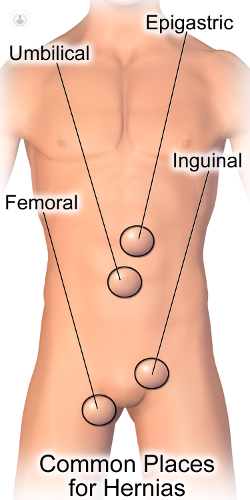Femoral hernia
Mr Dominic Coull - Colorectal surgery
Created on: 04-17-2018
Updated on: 03-22-2023
Edited by: Conor Dunworth
What is a femoral hernia?
A femoral hernia is fairly uncommon and is most commonly found in women. Femoral hernias are found in the groin region and can appear as a painful lump on the inner, upper thigh. The lump can be pushed back in and can sometimes become more prominent when straining or coughing. It is estimated that only 1 in 20 groin hernias are femoral hernias, and are mostly inguinal hernias. They are more common in women because women have a wider pelvis.

What are the symptoms of a femoral hernia?
Some people with a femoral hernia do not notice any bulge, lump or pain, however, larger femoral hernias produce a visible bulge in your upper thigh which can be painful, especially when straining.
What causes a femoral hernia?
A femoral hernia is the result of fatty tissue or a section of the bowel protruding through into the groin on the top of your inner thigh. The section where the protrusion can occur is called the femoral canal and is considered a weak spot in the abdominal wall muscles. The actual causes of a femoral hernia are:
- heavy-lifting
- straining on the toilet
- obesity
- a persistent, heavy cough
- childbirth

What is the treatment for a femoral hernia?
Unlike other types of hernia, femoral hernias usually require treatment straight away due to potential complications associated with them. Surgery can be performed to put the bulge back into place and to fix the weakened abdominal wall. Complications that can result from femoral hernias include:
- Obstruction, where part of the bowel can become stuck in the femoral canal resulting in nausea and pain
- Strangulation, where the stuck section of bowel has its blood supply cut off (ischaemia), which required immediate surgical attention so that blood supply is restored and the tissue doesn’t die
Surgery for treating femoral hernias can either be open surgery, or it can be performed laparoscopically. Patients can usually return home either the same day or the following day.
What does femoral hernia repair entail?
Surgery for treating femoral hernias can either be open surgery, or can be performed laparoscopically. Patients can usually return home either the same day or the following day.
Open surgery is sometimes necessary. This is when the surgeon will make an incision to repair the hernia. Open surgery usually involves a longer recovery time and more pain.
Laparoscopic surgery is usually preferred, as it involves less pain and an easier recovery period. To perform a laparoscopic (or keyhole) surgery, the doctor will make smaller incisions. A small camera is inserted into the body so the surgeon can see what they’re doing, and the push the hernia back to the right place.
How long does it take to recover after femoral hernia surgery?
It typically takes around 6 weeks for the patient to make a full recovery following femoral hernia surgery. After about 2 weeks, most people can return to their normal daily activities such as going to work and driving.

Will a femoral hernia go away on its own?
No, femoral hernias will usually not go away on their own. Restoring the strength of the abdominal wall can usually only be done by surgery. If the femoral hernia is very small, it may not require surgery.
Is it ok to exercise with a femoral hernia?
It is ok to partake in light exercise when recovering from a femoral hernia, and exercise such as going for a walk can speed up the healing process. However, any heavy lifting or strenuous exercise should be avoided when recovering from a femoral hernia, as this can undo the surgery.

What can aggravate a femoral hernia?
There are a number of ways in which a femoral hernia may worsen or become aggravated. These include:
- Standing up suddenly
- Lifting or pushing heavy objects
- Straining on the toilet when suffering from constipation
- Suffering from a persistent, heavy cough
Which specialist treats a femoral hernia?
General surgeons typically treat femoral hernia.






